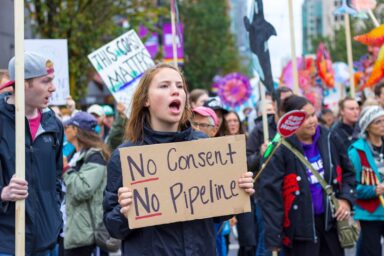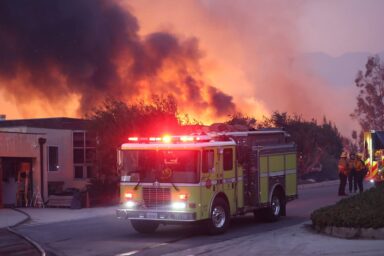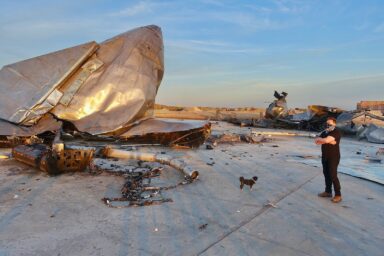The Fifth National Climate Assessment, released last month, warns of wide-ranging climate impacts throughout the United States. The implications for people and the environment in the Mississippi River basin are extreme, but experts stress that it is not too late to slow the worsening effects.
|
Listen To This Story
|
This story is a product of the Mississippi River Basin Ag & Water Desk, an independent reporting network based at the University of Missouri in partnership with Report for America, with major funding from the Walton Family Foundation.
Written by Delaney Dryfoos, this story was originally published at Investigate Midwest, and is part of Covering Climate Now, a global journalism collaboration strengthening coverage of the climate story.
•
The Fifth National Climate Assessment, released last month, warns of wide-ranging climate impacts throughout the United States. The implications for people and the environment in the Mississippi River basin are extreme, but experts stress that it is not too late to slow the worsening effects.
From its headwaters in Minnesota to its salty mouth at the Gulf of Mexico, the Mississippi River stretches across two regions of the country — the Midwest and the Southeast. The entire basin, including the river’s many tributaries, extends across five regions. The past two summers have brought extreme drought — threatening crops and shipping; extreme heat; and isolated extreme precipitation and flooding. The national report finds this will become common in the future.
The report is clear in its indictment of human activity as the cause for increasing global average temperatures. Within the contiguous US temperatures have risen by 2.5 F since 1970, compared to a global average rise of about 1.7 F over the same period.
While this rise in temperature can be attributed to the release of greenhouse gases around the world, the report highlights a number of human activities that drive the economy throughout the Mississippi River basin, including agriculture and shipping.
But there is still opportunity to adapt the Mississippi’s industries to safeguard the nation’s largest watershed.
Agriculture and Other Impacts in the Midwest
The report attributes climate change to human activities. The increased concentration of greenhouse gases in the atmosphere comes primarily from burning fossil fuels, but deforestation and agricultural practices are also contributors.
These gases have led not only to increased temperatures, but also to more frequent and severe extreme weather events. In the Midwest, extreme weather swings wreak havoc on both crops and communities.
Impacts on agriculture and food production are “(some) of the most visible and concerning aspects of climate change,” John Baker, a research leader with the US Department of Agriculture, said during a briefing about the report.
The Midwest is one of the most intensive agricultural regions in the world. Although average corn and soybean production have increased in recent decades, these gains will not last. The report predicts that extreme swings in precipitation will diminish future crop yields as well as animal production.

Photo credit: Mark Weber / The Daily Memphian / Investigate Midwest
Precipitation patterns are changing across the Midwest, with winter and spring precipitation expected to increase, while summer and autumn precipitation is expected to be more variable. These changes can already be seen in agriculture, with earlier snowmelts causing wetter springs that have delayed corn planting by up to a month in some places.
Episodic droughts have also reduced crop yields, despite increasing annual rainfall. Lack of rain brought drought to the Mississippi River basin this summer, and the drought is expected to linger into the winter, according to the US Army Corps of Engineers.
Once the drought passes, riverine flooding is expected to increase in the Ohio, upper Mississippi and parts of the Missouri Rivers. This high-water and longer-lasting flooding is also expected to negatively impact the Mississippi River basin’s floodplain forests by soaking the trees more than they can stand.
Periods of high rainfall are also causing damage through the runoff of fertilizers from farmland into the Mississippi River. The runoff has increased in recent decades and is expected to continue to increase, eventually dumping into the Gulf of Mexico where it creates a vast “Dead Zone.” This year’s was almost as big as Yellowstone National Park.
Shipping and Impacts in the Southeast
In the lower Mississippi, where nitrogen runoff from the upper basin meets salt water from the Gulf of Mexico, extreme drought has dominated the headlines over the past two years. The flow of the mighty Mississippi has not been enough to keep salt water from intruding up the river, threatening drinking water. As of Nov. 20, the saltwater wedge is holding steady 63.2 river miles into Louisiana.
Rising sea levels are adding to the threat of saltwater intrusion. The report predicts that over the next 30 years, coastal sea levels along the contiguous US will rise about 11 inches, which is roughly equivalent to the observed rise over the last 100 years. On the Gulf Coast, land lost to the sea has been accelerated by groundwater and fossil fuel removal.
The shipping industry is already feeling the effects of climate change, and looking for ways to adapt to these increasingly chronic problems. This year’s low water conditions have come at an inopportune time for the basin’s economy: harvest season.
The drought has led to a severe disruption in barge transportation that is causing economic hardship for farmers. The kink in this river supply chain is slowing both the import and export of goods at a major gateway for the country, a disruption that the report predicts can lead to job loss if it becomes regular.

Photo credit: Nick Rohlman / The Gazette / Investigate Midwest
This summer’s drought coincided with the hottest year ever recorded on Earth. New Orleans tied with two cities in Indonesia for the second-longest streak of extreme heat, measuring in at 17 days straight. The wetlands around New Orleans became so parched that a swamp fire burned for more than a month.
The current drought should not obscure the possibility of flooding yet to come. The report details an increase in severity and frequency of extreme weather events. For the Mississippi River basin, Jill Trepanier, an associate professor at Louisiana State University studying weather and climate, is most concerned about the extreme variability in precipitation.
“One year can be very different than the next,” said Trepanier. “That’s part of the expectation now, these really big differences.”
Extreme Opportunities
Many climate researchers who were not a part of writing the federal report were happy to see it emphasize climate justice. Extreme heat, drought, flooding, wildfire smoke, and vector-borne disease won’t impact all residents equally. As defined by the report, climate justice is the recognition of diverse values and past harms, equitable distribution of benefits and risks, and the procedural inclusion of affected communities in decision-making processes. This includes many of the communities on the frontlines of the changing Mississippi River basin.
“We’re not all experiencing the impacts of changing climate conditions equally. Communities of color, low-income communities, and indigenous people are some of the most disproportionately affected by climate change and extreme events,” said Deepti Singh, an author of the report’s chapter on Climate Trends.
The report makes a point to focus on the knowledge of Indigenous peoples and the importance that self-determination can have on their resilience to climate change. One example focuses on how warming and the distribution of water endangers wild rice, a culturally significant crop for Midwest tribes.
A chapter on Tribes and Indigenous Peoples highlights a research project undertaken by the College of Menominee Nation in Keshena, Wisconsin to help the community understand how climate change is affecting plants on the Menominee Indian Reservation, the largest reservation east of the Mississippi River.
The Milwaukee Journal Sentinel has reported on how the knowledge of Great Lakes tribes could be key to navigating climate change in the Midwest. This year, wild rice crop was decimated by a fungus causing brown spot disease, which researchers believe is spreading quickly from the more humid weather ushered in with climate change.
The report recognizes that increasing temperatures, sea level rise, and changing precipitation patterns are also causing extreme weather events, like more intense hurricanes on the Gulf Coast.

Photo credit: Nick Rohlman / The Gazette / Investigate Midwest
Other disasters may be more surprising, such as the increased likelihood that tornadoes will hit the lower Mississippi River basin. “Tornado Alley,” typically considered to be centered over the Great Plains, is shifting eastward. Tornadoes are also becoming more frequent during the fall and more intense.
“It’s called extreme climate change because it’s not completely in one direction or the other,” said Rebecca Malpass, director of policy and research at The Water Collaborative in New Orleans. Both droughts and floods will become more intense. “We’re going to keep oscillating between these two extremes more frequently as the decades go on.”
Adaptation — like improving flood management, building energy microgrids, and testing early warning systems — are key to protecting millions of people, as well as the economy throughout the basin. While adaptation is occurring on a piecemeal basis, the report concludes it’s not happening fast enough to reduce even today’s climate-related risks.
As the pace of climate change and extreme weather hastens, adaptation will need more investment. The Biden Administration has already made some historic investments, including the Bipartisan Infrastructure Law and the Justice40 Initiative, which dictates that 40 percent of federal climate investments go to disadvantaged communities.





